Did you know 70% of foundation repair costs stem from improper yard drainage? A single inch of rainwater can funnel thousands of gallons toward your home’s base, threatening its structural integrity. Proper lawn grading helps redirect water away from your foundation, preventing cracks, basement flooding, and costly repairs before they start.
We’ve seen countless properties struggle with slopes that pull water inward instead of guiding it away. When your outdoor space tilts toward your house, even routine storms become risks. The solution lies in reshaping your land’s contours to create a gentle, protective slope.
Our team specializes in turning problematic yards into functional, beautiful landscapes. Whether you’re battling puddles that linger for days or uneven terrain that ruins curb appeal, strategic adjustments make all the difference. Properly angled soil doesn’t just prevent damage—it elevates your entire property’s value and visual harmony.
Key Takeaways
- Sloping terrain toward your home risks foundation damage from water accumulation
- Ideal grading directs water 6-10 feet away from structures
- Correcting drainage issues preserves landscaping investments
- Professional grading boosts property value by up to 15%
- 24/7 expert support available at +1-833 888 2533 for urgent needs
Let’s explore how to achieve slopes that work with nature rather than against it. From initial assessments to long-term maintenance, we’ll guide you through creating an outdoor space that protects and enhances your home.
Introduction to Lawn Grading
Many homeowners don’t realize their property’s angle could be funneling thousands of gallons toward their house annually. Even minor dips or flat spots near your home foundation create perfect conditions for pooling water – nature’s most persistent home invader.
Defining Yard Grading
We consider yard grading the art of redirecting nature’s flow. It’s not just moving dirt – it’s engineering a 3-5% incline that guides rainwater 6-10 feet away from structures. For every 10 feet of space, the ground drops 6 inches to create this protective barrier.
Our team always starts with laser measurements. “A 2% miscalculation in slope can double erosion risks,” notes a structural engineer we collaborate with. That’s why precision matters more than guesswork when safeguarding your foundation.
Why Slope Dictates Your Home’s Future
Imagine your property as a shield. A proper slope yard setup acts like armor, deflecting 90% of stormwater threats before they reach your basement walls. Without this defense, hydrostatic pressure builds up – the main culprit behind cracked walls and sinking floors.
We’ve resolved cases where correcting drainage added $12,000+ to home values. It’s not just about avoiding damage; it’s about creating landscapes that work smarter. When water flows where it should, your home foundation stays dry, and your outdoor spaces become usable year-round.
Key Benefits and Challenges of Yard Grading
Your outdoor space does more than grow grass—it’s your first defense against nature’s surprises. When water moves the wrong way, even sturdy homes face hidden risks. We help turn these challenges into lasting solutions that protect and beautify.
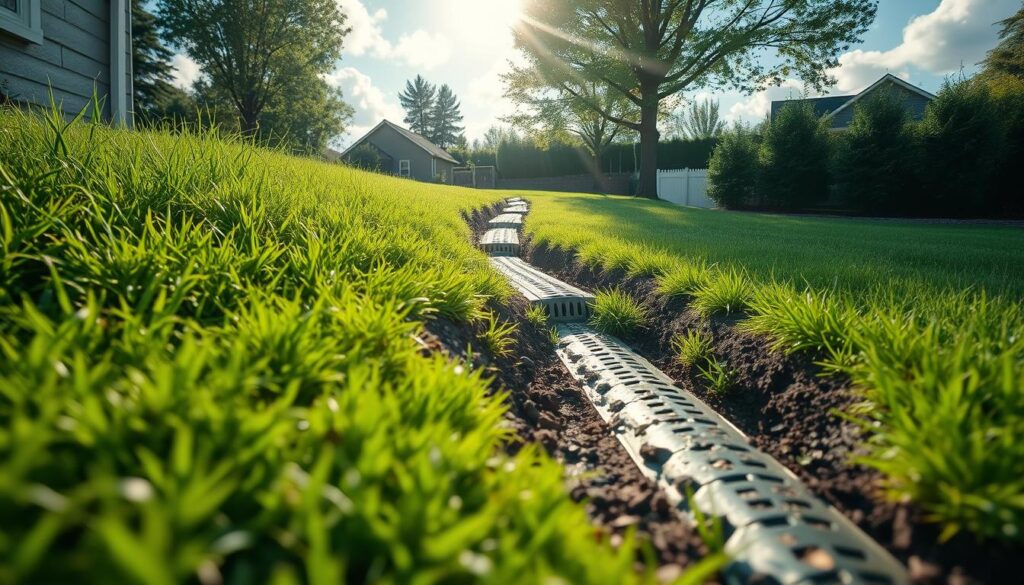
Preventing Drainage Issues and Erosion
Standing water becomes a mosquito nursery in 48 hours. Our methods eliminate these breeding zones by creating smart slopes that guide moisture away. No more soggy patches that ruin shoes or drown plants.
Erosion steals 2 inches of topsoil annually in poorly sloped areas. We rebuild your terrain to keep nutrients where they belong. Trees and shrubs thrive when their roots aren’t swimming in excess moisture.
Enhancing Curb Appeal and Property Value
Crisscross mower tracks scream neglect. Our precision adjustments create smooth surfaces that impress neighbors and buyers alike. A dry, even yard adds visual harmony that flowers can’t match.
| Common Problem | Our Solution | Result |
|---|---|---|
| Muddy walkways | Strategic slope creation | Clean hardscapes |
| Spongy soil | Compaction techniques | Stable surfaces |
| Pooling water | Drainage channels | Dry root zones |
| Uneven terrain | Laser-guided leveling | Professional appearance |
Homes with resolved drainage issues sell 11% faster in competitive markets. Buyers recognize the value of a yard that works smarter, not harder. Let’s turn your outdoor headaches into neighborhood showpieces.
Essential Tools and Materials for Your Project
Ever wonder why some DIY projects succeed while others become weekend nightmares? The secret often lies in choosing the right gear. Let’s explore what you’ll need to reshape your outdoor areas effectively.
DIY Tools for Homeowners
For modest adjustments near patios or walkways, start with basics. A sturdy shovel and landscaping rake handle most surface-level work. Add a wheelbarrow for moving soil efficiently – these three items form your foundation.
Medium-sized jobs demand more muscle. Our team recommends renting a power tiller to break up compacted ground. Pair it with a tamper to create stable surfaces. “Proper compaction prevents 80% of settling issues,” notes a contractor we partner with.
When to Consider Professional Equipment
Large properties often need heavy machinery. If you’re reshaping half an acre or more, bobcats and mini-excavators save weeks of labor. These machines move topsoil precisely while maintaining consistent slopes.
Calculate material needs using cubic yard measurements – one truckload typically covers 10-12 square yards. Always order 15% extra soil to account for settling. For lasting results, layer fill dirt beneath nutrient-rich topsoil.
Don’t forget measurement tools! String levels and stakes ensure your project maintains the correct 2% slope. Safety gear like gloves and steel-toe boots protect during extended work sessions.
Lawn Grading: Step-by-Step Process
Starting a yard grading project without proper planning often leads to wasted effort. We begin every job by understanding your land’s unique story – its slopes, dips, and hidden drainage patterns.
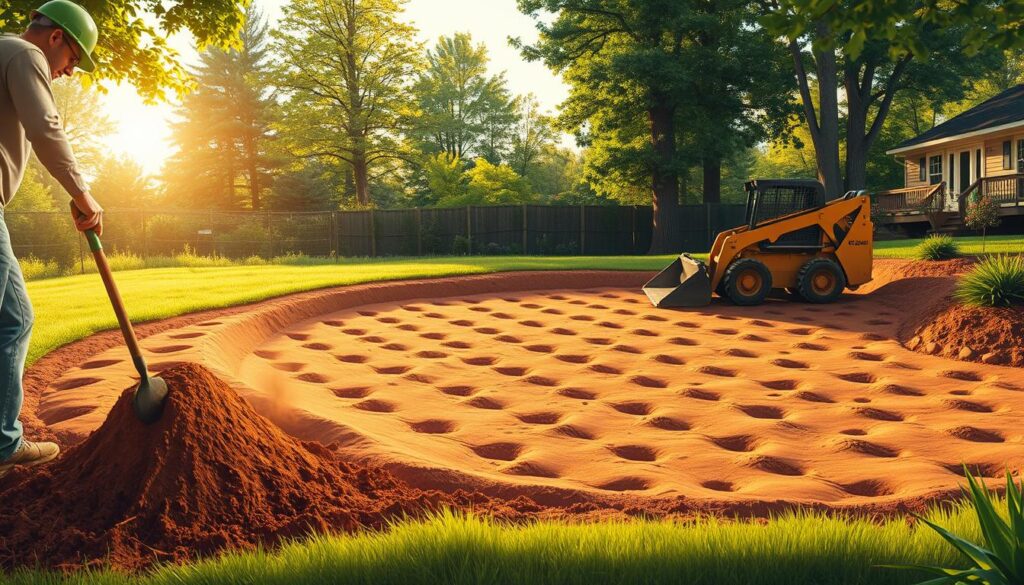
Assessing the Current Slope and Drainage
Grab two stakes and string to reveal your property’s secrets. Place the first stake near your foundation, then measure 100 inches outward. When the string level shows a centered bubble, check the height difference. Divide by 100 – that’s your slope percentage.
We mark trouble spots with bright flags so nothing gets missed. High areas get trimmed, while low zones need filling. Documenting these details creates a roadmap for your grading project.
Preparing, Distributing, and Tamping the Soil
Peel back the top 4 inches of soil like lifting a carpet. The firm layer underneath becomes your new ground foundation. Start piling fill dirt near structures, sloping downward as you move outward.
Our team uses plywood sheets to compact earth evenly. Three passes with a tamper create surfaces that won’t sag later. “Proper compression prevents 90% of settling issues,” says our lead landscaper.
Final checks involve re-measuring every 5 feet. We make sure water flows away naturally before replacing topsoil. Your renewed surface then stands ready for grass seed or decorative stones.
Understanding Slope Measurements and Drainage
What if your yard’s angle could make or break your home’s defense system? Precise slope calculations turn guesswork into guaranteed protection. Let’s break down the numbers that keep your property dry and stable.
Calculating the Ideal Slope for Yard Grading
We use a simple formula: Drop (inches) ÷ Distance (feet) × 100 = Slope %. For every 10 feet from your foundation, aim for 2-5 inches of downward slope. That means a 5% grade creates 6 inches of drop across 10 feet – enough to send water away without causing erosion.
Here’s our quick-check method:
- Place stakes 8-10 feet apart
- Attach string with a line level
- Measure vertical difference between stakes
Interpreting Grade Percentages for Safe Runoff
Slopes under 2% trap water. Anything over 25% risks washing away topsoil. We’ve found 3-5% creates the Goldilocks zone – fast enough drainage without erosion. “A 4% slope moves 15 gallons per minute away from structures,” notes our lead hydrologist.
| Slope % | Drop per 10ft | Drainage Speed |
|---|---|---|
| 2% | 2.4″ | Slow |
| 5% | 6″ | Ideal |
| 25% | 30″ | Dangerous |
Steep slopes need terracing. Flat areas require strategic mounds. Our laser tools map your grade yard in 3D, showing exactly where to add or remove soil. Remember – proper drainage starts with understanding these numbers!
DIY vs. Professional Yard Grading: Making the Right Choice
Ever stared at a shovel wondering if it’s worth the sweat? We help homeowners navigate the DIY vs professional crossroads daily. Small adjustments near foundations often work for hands-on types, but steep slopes or large areas demand expert solutions.
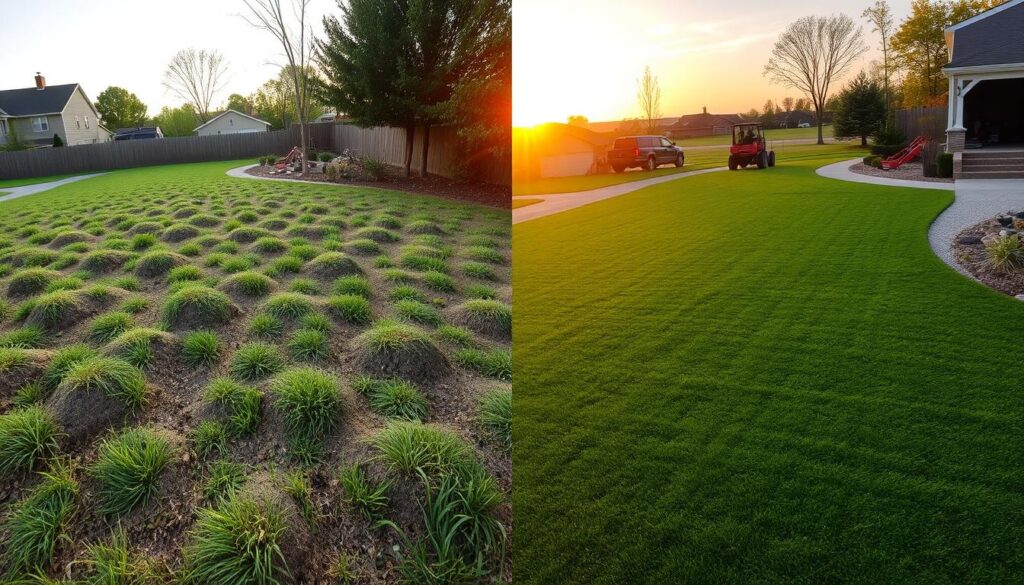
Assessing the Scope of Your Project
Our team evaluates three key factors:
| Project Size | Time Required | Cost Range | Best For |
|---|---|---|---|
| Under 500 sq ft | 5-7 days | $500-$1,000 | DIY enthusiasts |
| Over 1/4 acre | 2-3 days | $1,000-$5,000 | Professional crews |
“Steep slopes over 25% grade turn simple projects into safety hazards,” warns a Maryland excavation specialist we partner with. We recommend pro help when dealing with:
- Utility lines near work zones
- Existing drainage systems
- Properties with multiple elevation changes
For minor fixes like patio edges or single-wall adjustments, DIY makes sense. But when labor costs hit $50/hour and heavy machinery enters the picture, our crews finish in half the time with guaranteed results.
Call our 24/7 support at +1-833 888 2533 if your grading yard project involves complex terrain or tight deadlines. We’ll help you weigh time investments against long-term property protection.
Maintenance and Aftercare for a Healthy Lawn
Your newly shaped outdoor space deserves care that lasts beyond the initial project. Immediate action preserves both beauty and functionality. We’ve seen properties transform when owners follow these science-backed strategies.
Roots, Water, and Soil Harmony
Plant grass seed or sod within 48 hours of completing your project. These roots stabilize topsoil 3x faster than bare earth. “Newly shaped soil needs immediate protection,” advises our lead landscaper. “Grass roots act like nature’s glue, binding the earth within days.”
Follow our phased watering plan:
| Week | Frequency | Duration | Goal |
|---|---|---|---|
| 1-2 | Daily | 15 mins | Seed germination |
| 3-4 | Every 3 days | 30 mins | Root development |
| 5+ | Weekly | 45 mins | Drought resistance |
Monitor water absorption rates. If puddles form, reduce duration but maintain frequency. Compacted areas might need aeration – we recommend core perforation every spring.
Seasonal checks prevent surprises. Inspect slopes after heavy rains, looking for:
• Exposed roots (indicates erosion)
• Sunken spots (signs of settling)
• Moss growth (shows poor drainage)
Our team provides customized fertilization plans based on soil tests. Balanced nutrients keep grass vigorous without overwhelming your landscaping system. Remember: healthy turf is the ultimate erosion barrier.
Contact and Support Information
Your outdoor transformation deserves expert support at every step. We’re here to help you navigate challenges and celebrate successes – from initial plans to final touches.
Round-the-Clock Guidance
Dial +1-833 888 2533 anytime for real-time solutions. Our team answers questions about soil prep, slope calculations, or material choices – even during midnight downpours. Let’s keep your project moving forward smoothly.
Local Expertise, Regional Roots
Visit us across the DMV:
• DC: 2315 Wisconsin Ave NW
• Rockville: 330 N Stonestreet Ave
• Ashburn: 44121 Leesburg Pike
Stop by to discuss your yard needs face-to-face. We’ll map out strategies tailored to your home’s unique terrain.
Digital Connections Welcome
Email info@dmvwp.com for photos, sketches, or detailed queries. Attach pictures of problem areas – we’ll respond with customized advice within 24 hours. Your vision for a functional, beautiful yard starts here.
FAQ
What is lawn grading, and why is it important?
Lawn grading involves reshaping the soil to create a slope that directs water away from your home’s foundation. Proper grading prevents pooling, protects your property from water damage, and ensures healthy grass growth.
How do I know if my yard needs regrading?
Look for signs like standing water, soil erosion near the foundation, or uneven patches in your landscaping. If water flows toward your house instead of away, it’s time to consider regrading.
Can I tackle this project myself, or should I hire a professional?
Small areas with minor slope issues might be DIY-friendly using tools like a shovel, rake, and tamper. For larger projects, steep slopes, or complex drainage needs, we recommend professional equipment and expertise to ensure long-term results.
What’s the ideal slope for directing water away from my home?
Aim for a 2% slope (a 2-inch drop per 10 feet) around your foundation. This grade safely channels runoff away while preventing erosion. Use a string level or laser transit to measure accurately.
How long does a typical yard grading project take?
Timing depends on the size and complexity. A small DIY job might take a weekend, while larger projects with soil delivery, compaction, and landscaping adjustments could require several days or professional scheduling.
Will regrading damage my existing plants or landscaping?
We carefully plan projects to minimize disruption. Delicate plants may need temporary relocation, but strategic grading can enhance soil health and drainage for healthier growth long-term.
What maintenance is required after grading?
Keep an eye on drainage patterns, refresh mulch or topsoil as needed, and address erosion early. Regular lawn care like aeration and overseeding helps maintain even terrain and lush grass.
How can I reach your team for support?
Call us 24/7 at 1-833-888-2533, email info@dmvwp.com, or visit our offices in Washington, DC; Rockville/North Bethesda, MD; or Manassas/Ashburn, VA. We’re here to help!

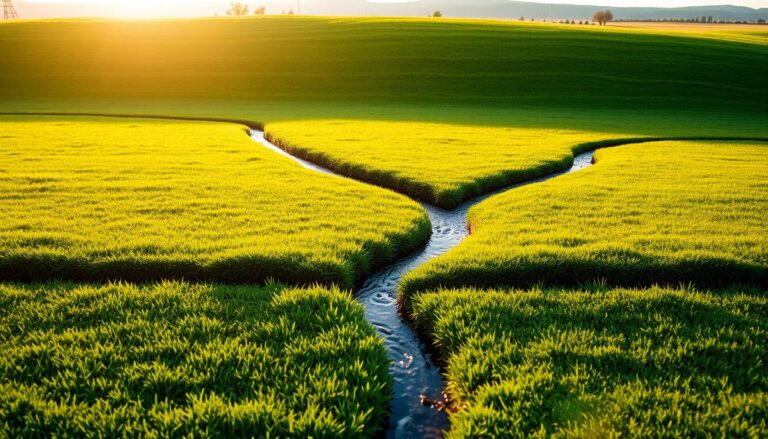
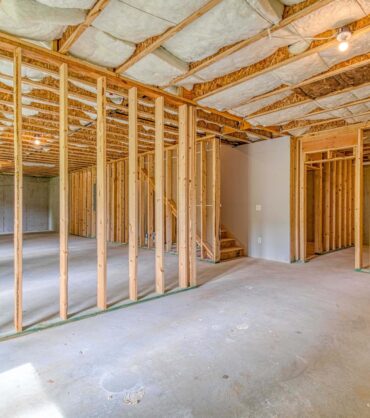
![[GetPaidStock.com]-680786795b816 [GetPaidStock.com]-680786795b816](https://dmvwp.com/wp-content/uploads/2025/04/GetPaidStock.com-680786795b816-370x418.jpg)
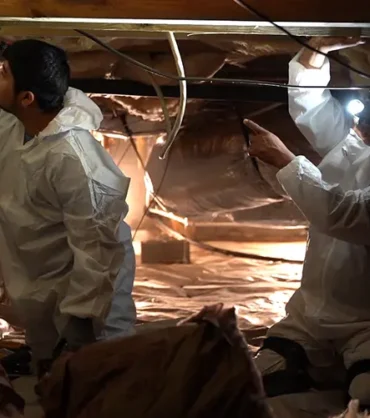
![[GetPaidStock.com]-682c400c87c15 [GetPaidStock.com]-682c400c87c15](https://dmvwp.com/wp-content/uploads/2025/04/GetPaidStock.com-682c400c87c15-370x418.jpg)
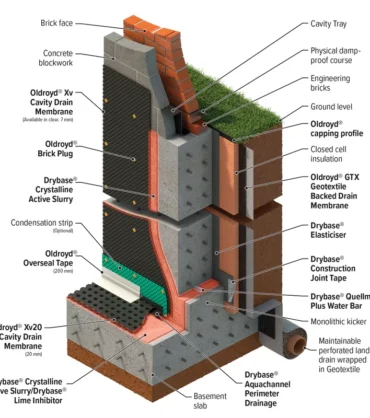
![[GetPaidStock.com]-682c413fa898e [GetPaidStock.com]-682c413fa898e](https://dmvwp.com/wp-content/uploads/2025/03/GetPaidStock.com-682c413fa898e-370x418.jpg)